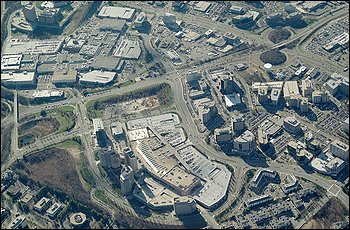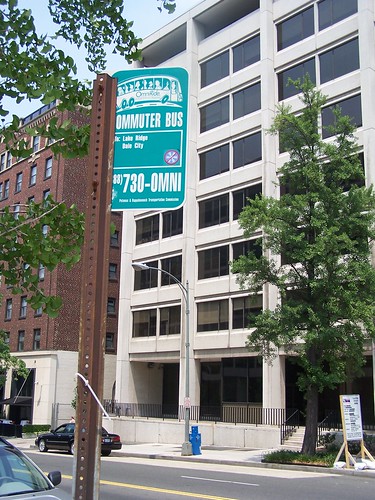A bifurcated regional transit policy: transit for commuters vs. transit to support compact development
A week or so ago, Ralph mentioned the irony of how the Dallas-Fort Worth proposes to use federal stimulus monies to support the extension of fixed rail transit (see "Regional focus shifts to funding streetcar system in Fort Worth, Dallas" from the Fort Worth Star Telegram) while in the DC region, instead the focus is on providing bus rapid transit (see "A Fast Track to a Busway: Agency May Seek U.S. Funds for Network of Special Lanes" and this editorial from yesterday "Get on the Bus" from the Post).

Riders gather at the Westlake station to board the Sound Transit Light Rail trains on Saturday. Steve Ringman / The Seattle Times.
This is also interesting from the standpoint of the opening of the first modern light rail line in Seattle this past weekend (see "First day passengers pay for Seattle light rail" and "Light rail shows Seattle is 'growing up'" from the Seattle Times) which follows the recently opened (December 2007) Seattle Streetcar line in the redeveloping South Lake Union neighborhood.
Regionally, there are two conflicting goals in transit policy. The first is over getting people to and from work, in the major office agglomerations in the region such as in Downtown DC, Crystal City and the Rosslyn-Ballston corridor in Arlington County, Bethesda, Silver Spring, along the I-270 corridor, and of course in the Tysons Corner region of Northern Virginia.

Aerial view of Tysons Corner. Fairfax County photo.
The other has to do with focusing on compact development and trip reduction through developing and/or augmenting places where mobility is accomplished without the automobile--by walking, bicycling, and through transit.
Belmont, in Cities in Full, discusses this in the context of creating "polycentric" mobility systems focused on enabling sprawl, or monocentric systems oriented on the core of a region, and focused on compact development and the linking of housing, commerce, and other amenities.

Protest against I-66 in Downtown Washington, early 1970s. DC Dept. of Transportation photo.
This difference in approach reared its ugly head a few months ago, over the issue of adding lanes to the I-66 freeway, which found Arlington County, which promotes a balanced approach to transportation, and is vigilant against the County being overrun by traffic from other places, and Fairfax County on different sides of the issue. For a time, Arlington successfully warded off expansion of the freeway. See "Vote to Forgo I-66 Expansion Imperils Federal Funds, Increases Ire" and "Fairfax Planning to Undo I-66 Decision" from the Washington Post.
At least Arlington is out there representing its interests. DC is on the bandwagon for bus rapid transit, which has some marginal benefit for maintaining the economic viability of downtown DC as a place to do business, but really shouldn't be seen a primary component of a DC-centric (albeit regionally embracing and complementary) transportation plan.
This difference in approach to transit also influences the debate over the Purple Line light rail system being proposed for Montgomery and Prince George's Counties. See "Both Md. Hands Out For U.S. Transit Aid: Baltimore, D.C. Area Plans Pursued" from today's Post.

Light Rail in Barcelona. Photo by John Norquist.
European cities demonstrate that light rail--cheaper than heavy rail, especially underground systems, which cost at least $400 million/mile just for tunneling--can be well integrated into urban environments in ways that strengthen the quality of place, unlike light rail systems that are typically built in the U.S.
I don't know how anyone can argue with a straight face, if they have ever ridden a bus in the DC region and if they have also ridden the WMATA subway system, that bus service is equal in quality to subway transit service. (Regional commuter buses do provide comparable service. But the cost for a ride is significantly more, and these buses typically have seats for about 60 people.)

So arguing to the contrary, as Kathy Strom and Patricia Burda, stalwart defenders of the status quo in Chevy Chase, do in this piece in yesterday's Post, "The Purple Line's Real Toll" just can't be taken seriously.
It happens the Montgomery County Maryland has one of the most successful suburban bus systems in the United States in the RideOn system, which is designed to link to and be complementary to the subway system.
And it happens that the WMATA subway system has the second most number of riders of any fixed rail transit system in the United States.
And it happens that in most regions in the United States, not many people, all things considered, ride bus rapid transit systems. In fact, many traditional bus lines in DC proper have greater ridership than such systems, especially those in Pittsburgh.
But because some of the people in the Town of Chevy Chase don't want a light rail system to go through their community--unlike say people in Paris, Bordeaux, Lyon, Barcelona, Nice and other European cities--because obviously Chevy Chase knows something that Paris doesn't, they labor and belabor every possible weak argument they can.
Plus, by connecting to both segments of the red line, as well as the orange line, the network aspects of the fixed rail transit system will be extended and strengthened, significantly adding to ridership in ways that the present scoring methodology doesn't really consider.
But in the end, it comes down to how does the region want to develop. For DC and Montgomery County (see "Rollin Stanley talks Montgomery County Growth" from the Washington Business Journal) and Arlington County, it is about strengthening the core and redirecting development towards the core, but with an urban form that focuses on compact development and optimal mobility.
For Fairfax County and points west (Loudoun, Prince William, etc.) it is about providing the means for their residents to come into the core to earn money to bring back home. For Chevy Chase, it's about not having a train line through their community, even though a railroad line once traversed the same route...
I am not sure that this contradiction can be resolved.
But I can guarantee that if DC doesn't specifically represent its interests, transportation policy in the region will continue to directed towards supporting sprawl rather than supporting the core.

WMATA polycentric rail system, from Cities in Full.
Labels: car culture and automobility, sustainable land use and resource planning, transit, transportation planning, urban design/placemaking, urban economics, urban revitalization, urban vs. suburban



0 Comments:
Post a Comment
<< Home